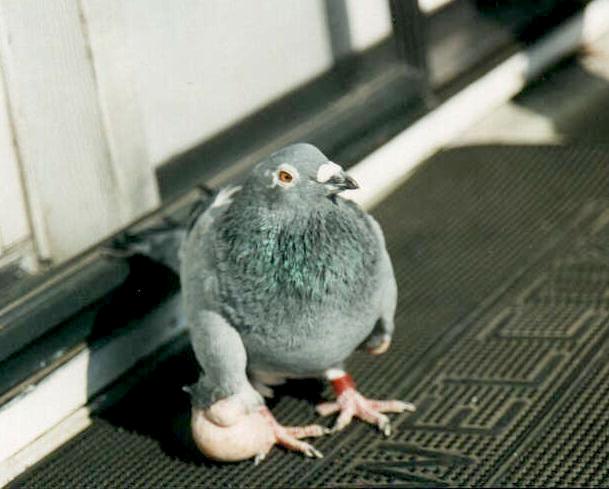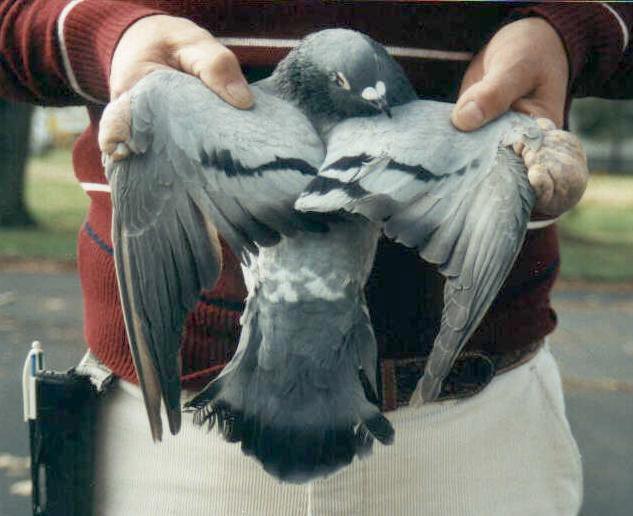pigeons Wing-tumors in Pigeons
By Robert J. Mangile, 1992
It started around the Spring of 1982, when I noticed an albino(1) hen (503-C/APC-77-HA-4955) with enlargements at the ends of both wings. At first glance it looked as though she injured the fleshy portions of the lower wing tips and the healing process was underway. But upon closer examination the wings were not injured and the enlargements were soft, tumor-like swellings visible below both closed wings. They grew larger with time and on June 14, 1982 I photographed this hen to document the malady.
On January 15, 1983 this hen was given to Dr. Willard F. Hollander at the N.P.A. National Pigeon Show held in Lincoln, Nebraska. Hollander later reported that she produced three normal male offspring before her death on July 22, 1983; and that... "Her tumors grew so big she was almost unable to walk, dragging the wings.".
The bilateral (affecting both sides) development of these tumors suggested a hereditary cause. I mentioned this hen in the "Information Please!" column on page 26 of the May 1989, A.P.J. and hinted at the possible hereditary nature of the tumors. (The article contained an error, giving her hatch date as August 20, 1982; but her actual hatch date was on August 20, 1980.) She was almost three years of age when she died.
It appeared that the book was closed on the matter but on September 7, 1991, I discovered an erratic(2) blue bar hen (778-C1/AU-86-KC-8867) with similar wing tumors. This bird hatched on July 20, 1988, and was a grand-daughter to the original albino hen. She and her mate (pair 1223) were placed in a separate breeding coop. Her tumors gradually enlarged, with the right one disproportionately larger (see Figures 1 & 2); and she broke most of her eggs before I could move them to foster parents. As of October 10, 1992, I have only four of her offspring.

Figure 1.
Front view: Erratic blue bar hen, #788-C1/AU-86-KC-8867, showing large
tumor on right wing touching the ground and smaller tumor on left wing.
(Photo by Ron Mangile)

Figure 2.
Top view: Erratic blue bar hen #788-C1/AU-86-KC-8867. Taken November 7, 1992; the left wing-tumor about the size of a mans thumb; while the right wing-tumor has grown to the size of a small lemon. (Photo by Ron Mangile)
With nagging doubts about tackling this project, more convincing evidence became available. On September 24, 1992, while culling birds, yet another bird was found displaying the early signs of the now familiar wing tumors. Small fleshy enlargements were visible at the extreme ends of both wings over and around the last wing bone (phalanx). This bird was an erratic indigo blue bar cock (788-R/APC-83-HB-744), hatched on May 2, 1987, and is a full sibling to the erratic blue bar hen (788-C1).
These two siblings (788-R & 788-C1) are the only ones found in over 20 produced in mating #788. It is relevant to mention that over the years many birds from my stock have been distributed to fanciers across the Country. I'd be interested to learn of any similar cases, especially those found in lofts that imported my stock?
The late development of the tumors hamper investigation. Birds must be kept for several years to observe such development. The erratic indigo cock is about a year older than the erratic blue bar hen but the tumor development is just developing; whereas the tumors on the younger erratic hen are noticeably larger. Perhaps hormones related to sexual differences or breeding conditions play a role in creating a predisposition for the development of wing-tumors. It seems unlikely that these tumors are a result of food stuffs or chemicals. No other birds in my flock were found with this malady. Hence, under the pretense that the 'wing-tumors' are the results of a recessive gene, I have adopted the genetic symbol of 'wt' to represent 'wing-tumor'.
A final analysis of the cause of this malady may never be completed. It would seem that at least a portion of the pigeon fancy might find some interest in this report; but more importantly, it may generate interest in researchers in the field of oncology (the branch of medicine dealing with tumors). [Samples of the large wing-tumor of the bird in photos were later sent to Iowa State University in Ames, Iowa and were found to be "cholesterol tumors".]
----------
(1) Albino (genetic symbol = "al") is produced by a homozygous
recessive gene, which blocks all black pigment production. Typically, plumage
is white, eyes are pink and head slightly sways.
(2) Erratic (genetic symbol = "er") is produced by a homozygous
recessive gene, which produces behavioral characteristics that include:
a head tremor, uncontrollable flight direction and difficulty picking-up
grain. Erratic squabs tend to stray and/or fall from the nest and often
get attacked by other adult pigeons.
----------